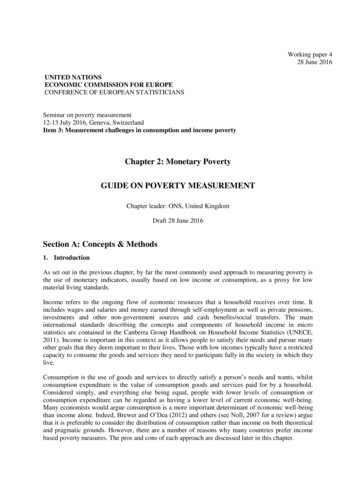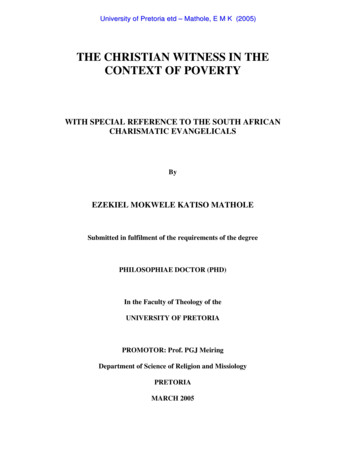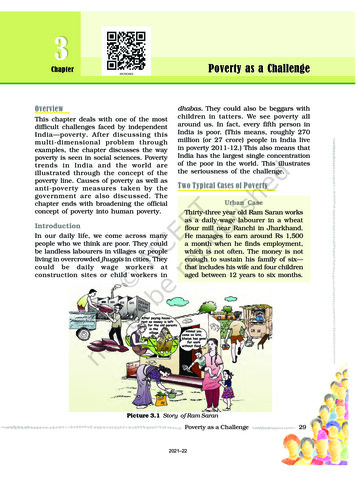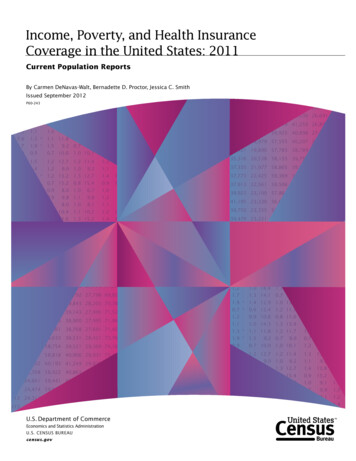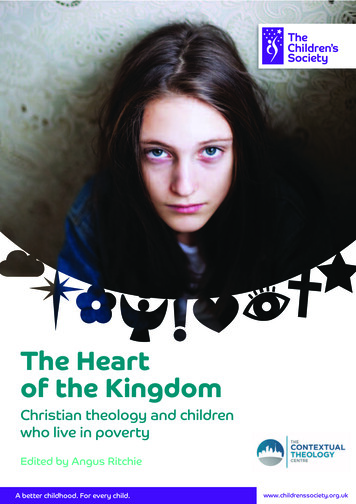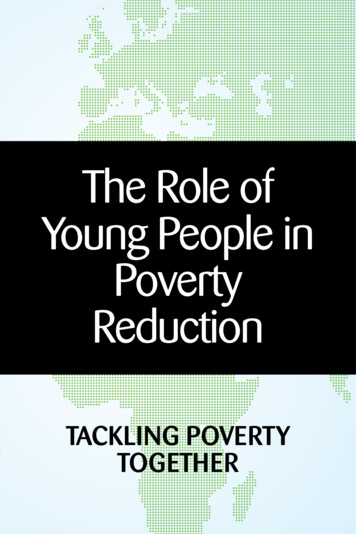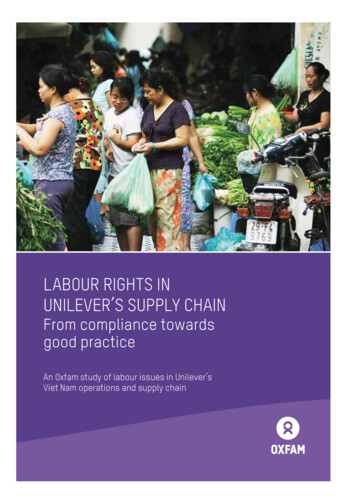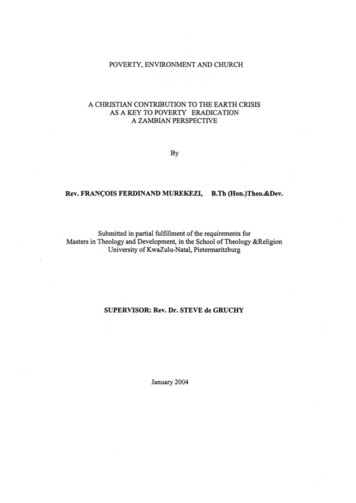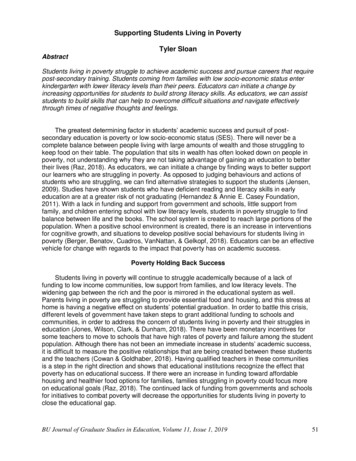
Transcription
Supporting Students Living in PovertyTyler SloanAbstractStudents living in poverty struggle to achieve academic success and pursue careers that requirepost-secondary training. Students coming from families with low socio-economic status enterkindergarten with lower literacy levels than their peers. Educators can initiate a change byincreasing opportunities for students to build strong literacy skills. As educators, we can assiststudents to build skills that can help to overcome difficult situations and navigate effectivelythrough times of negative thoughts and feelings.The greatest determining factor in students’ academic success and pursuit of postsecondary education is poverty or low socio-economic status (SES). There will never be acomplete balance between people living with large amounts of wealth and those struggling tokeep food on their table. The population that sits in wealth has often looked down on people inpoverty, not understanding why they are not taking advantage of gaining an education to bettertheir lives (Raz, 2018). As educators, we can initiate a change by finding ways to better supportour learners who are struggling in poverty. As opposed to judging behaviours and actions ofstudents who are struggling, we can find alternative strategies to support the students (Jensen,2009). Studies have shown students who have deficient reading and literacy skills in earlyeducation are at a greater risk of not graduating (Hernandez & Annie E. Casey Foundation,2011). With a lack in funding and support from government and schools, little support fromfamily, and children entering school with low literacy levels, students in poverty struggle to findbalance between life and the books. The school system is created to reach large portions of thepopulation. When a positive school environment is created, there is an increase in interventionsfor cognitive growth, and situations to develop positive social behaviours for students living inpoverty (Berger, Benatov, Cuadros, VanNattan, & Gelkopf, 2018). Educators can be an effectivevehicle for change with regards to the impact that poverty has on academic success.Poverty Holding Back SuccessStudents living in poverty will continue to struggle academically because of a lack offunding to low income communities, low support from families, and low literacy levels. Thewidening gap between the rich and the poor is mirrored in the educational system as well.Parents living in poverty are struggling to provide essential food and housing, and this stress athome is having a negative effect on students’ potential graduation. In order to battle this crisis,different levels of government have taken steps to grant additional funding to schools andcommunities, in order to address the concern of students living in poverty and their struggles ineducation (Jones, Wilson, Clark, & Dunham, 2018). There have been monetary incentives forsome teachers to move to schools that have high rates of poverty and failure among the studentpopulation. Although there has not been an immediate increase in students’ academic success,it is difficult to measure the positive relationships that are being created between these studentsand the teachers (Cowan & Goldhaber, 2018). Having qualified teachers in these communitiesis a step in the right direction and shows that educational institutions recognize the effect thatpoverty has on educational success. If there were an increase in funding toward affordablehousing and healthier food options for families, families struggling in poverty could focus moreon educational goals (Raz, 2018). The continued lack of funding from governments and schoolsfor initiatives to combat poverty will decrease the opportunities for students living in poverty toclose the educational gap.BU Journal of Graduate Studies in Education, Volume 11, Issue 1, 201951
Increasing government funding for families in poverty would be ideal, although thelikelihood of that happening immediately is low. The lack of financial support for families inpoverty has a trickle-down effect on how families are able to support their learners. Studentswho use programs for affordable lunches are the greatest predictor of poverty in schools (Joneset al., 2018). When families are struggling to provide food for children, they are often not able toprovide the educational support needed for students to be successful. The ongoing stress ofliving in a state of poverty creates a toxic home environment, and the students’ success atschool is hindered (Jensen, 2009). Students in poverty live in an environment that isunpredictable, which makes it difficult for them to make positive connections at school. Thestudents often have no input into when and where they move, and likely the parents are notmaking these choices voluntarily (Jensen, 2009). With parents struggling to provide food andhousing, extra educational opportunities such as trips, camps, or additional educationalprograms are not available because of financial restraints (Hernandez & Annie E. CaseyFoundation, 2001). With a break in learning occurring every year, it is difficult for students inpoverty to keep up with the class. When students in poverty start school, there is a small gap inachievement with their classmates, but without interventions this gap increases as they enterhigh school (Kuhfeld, Gershoff, & Paschall, 2018). The financial stress placed on families inpoverty inhibits the supports that a family can provide to students.Families living in poverty seldom create sufficient opportunities for students to build literacyskills. Literacy levels at an early age are an accurate indicator of later academic success.Children’s literacy development starts early in life, but students living in poverty will not beintroduced to the same vocabulary as their peers who are not living in poverty (Kuhfeld et al.,2018). This is a substantial setback in their development, and one that is difficult for thestudents to overcome. When students do not come from environments that promote languagedevelopment, they often lack the basic building blocks that language and literacy are built on(Raz, 2018). Students in poverty are coming into schools with a literacy deficiency, and the gapis difficult to close with no interventions.If initiatives focused on literacy are not put in place for students in poverty, families andstudents will continue to struggle to be successful academically. Funding to communities andfamilies in poverty is the key to address academic shortcomings (Jones et al., 2018). With lowfunding from governments and schools, low levels of support from families, and low levels ofliteracy entering kindergarten, students in poverty will have limited academic success.Throwing the Book at PovertyEducators hold the key to unlock the chains that poverty has on education: by creatingpositive school environments, providing opportunities for academic growth, and teachingpositive social behaviours, educators can help students in poverty find academic success.Developing a positive school environment for students in poverty creates a safe place forstudents to feel comfortable to take risks and find academic success (Davis & Warner, 2018). Inmy experience teaching students living in poverty, their home environment is not a place thatprioritizes academic growth. While there may be chaos and instability in homes of children livingin poverty, a positive school environment has been found to have a lasting positive effect on theacademic success and future for students living in poverty (Berman et al., 2018). Having anadult in the school who a student feels is an ally helps to create a safe environment. Thepositive relationship is built on trust and a belief that the student holds the potential for academicsuccess (Davis & Warner, 2018). When educators show a belief in a student’s academic ability,a student begins to believe in his/her own self-worth. Educators need to show a student theycare before a student will care to learn. When students feel valued and safe in an educationalenvironment, they will find greater academic success.Students living in poverty will not have the same academic opportunities as students livingwith wealth. Opportunities to increase reading and literacy skills, and an introduction to52BU Journal of Graduate Studies in Education, Volume 11, Issue 1, 2019
technology, will increase the probability of academic success. Schools have the resources andfacilities available to create opportunities for growth for students coming from families with a lowSES. After-school programs are widely used in areas with high poverty rates, and they provideinstruction and activities that would not be available to these families regularly (Bayless et al.,2018). Some of the programs used in the school I work at include an after-school math tutoringprogram and a drop-in basketball shoot around. After-school programs involving literacyinterventions are especially important in early years education. Students who participate inprograms early in their schooling gain more advanced language skills than their peers who donot take part in these programs (Bayless et al., 2018). The increase in vocabulary and literacyhas a direct effect on academic success. A successful strategy to increase literacy is to providestudents with books that can be taken home to read (Bayless et al., 2018). My school divisionaddressed this issue by creating several little free libraries around our city. The opportunity forfree literature gives anyone, and especially people living in poverty, an opportunity to take abook home at no charge. Providing an opportunity to build literacy skills by participating in afterschool programs and with free libraries will increase the academic success of students from lowSES.Reading is a very important skill, and so is the ability to use technology. Technology isexpensive. Students living in poverty struggle to access computers and are not confident to usetechnology or pursue a career involving it (Ball, Huang, Rikard & Cotten, 2017). Introducingstudents to technology will help to create feelings of comfort using it, and open up careerpossibilities for students who would not have had that chance. By becoming more familiar withtechnology such as computers and tablets, students open up opportunities for careers in thescience, technology, electronics, and mathematics (STEM) field. This is the fastest growing fieldfor employment after high school, and students will keep more doors open to possible careers,and extended educational opportunities, by increasing their comfort with technology. Creatingopportunities for academic growth in after-school programs involving literacy and technology willgive students living in poverty an opportunity to find academic success.Students living in poverty need to build stronger social behaviours to support theiracademic success. Students can build these skills at school with the help of educators, and athome with guidance from their families. Educators are not available to students struggling inpoverty all of the time, and they therefore need to help students develop positive socialbehaviours that will help them during difficult times. It is important for educators to model thebehaviours for students, and to educate themselves and learn effective strategies. Studentsliving in low SES struggle to afford proper mental health care and outside opportunities for skillbuilding. Students will seek guidance and support from their classroom teachers. Schools canwork to provide teachers with proper training and professional development opportunities, inorder to ensure that teachers can provide students with the supports they require to besuccessful (Isik-Ecran, Demir-Dagdas, Cakmakci, Cava-Tadik, & Intepe-Tingir, 2017). Withadequate training, educators can provide proper examples and opportunities for students inpoverty to build positive social behaviours.Along with positive teacher support, it is important to involve parents to help students buildsocial skills. A positive parental influence will assist in the child’s ability to use self-regulationduring times of difficulty (Liew, Carlo, Streit, & Ispa, 2018). Building strong social skills such asresiliency should be introduced to children at a young age, in order to help them functionindependently as they move into adolescence (Berger et al., 2018). Students who develop theseskills at a young age are more likely to use them in the future. It is important for students to buildresiliency and the ability to overcome feelings of anxiety, and to learn interventions that involvestress reduction, in order to build positive social behaviours (Berger et al., 2018). Increasingopportunities for students, educating teachers, and involving parents are the most effectivestrategies to help students develop positive behaviours. Educators can diminish the effect thatpoverty has on academic achievement by building safe school environments, makingeducational opportunities available, and building a student’s resiliency.BU Journal of Graduate Studies in Education, Volume 11, Issue 1, 201953
ConclusionStudents raised in low income families are likely to experience times of financial strain andtension in the home, which negatively affects achievement and their ability to interact withclassmates (Jensen, 2009). Without proper funding to support families and programs incommunities with high levels of poverty, there will continue to be a gap in academicachievement grounded in lowered opportunities for literacy development. Educators canconfront the problem by ensuring that learning spaces are inviting for students, increasing thenumber of after school programs offered, making literature available for students to take at nocost, and helping students to build individual skills that will help them to self-regulate duringstressful times (Bayless et al., 2018). Poverty is an obstacle on the path to academic success,but with support and guidance it can be overcome.ReferencesBall, C., Huang, K.-T., Rikard, R. V., & Cotten, S. R. (2017). The emotional costs of computers:An expectancy-value theory analysis of predominantly low-socioeconomic status minoritystudents’ STEM attitudes. Information, Communication & Society, 22(1), 105-128.doi:10.1080/1369118X.2017.1355403Bayless, S. D., Jenson, J. M., Richmond, M. K., Pampel, F. C., Cook, M., & Calhoun, M. (2018).Effects of an afterschool early literacy intervention on the reading skills of children in publichousing communities. Child & Youth Care Forum 47(4), 537-561. doi:10.1007/s10566-0189442-5Berger, R., Benatov, J., Cuadros, R., VanNattan, J., & Gelkopf, M. (2018). Enhancing resiliencyand promoting prosocial behavior among Tanzanian primary-school students: A schoolbased intervention. Transcultural Psychiatry, 55(6). 821-845.doi:10.1177/1363461518793749Berman, J. D., McCormack, M. C., Koehler, K. A., Connolly, F., Clemons-Erby, D., Davis, M. F.,. . . Curriero, F.C. (2018). School environmental conditions and links to academicperformance and absenteeism in urban, mid-Atlantic public schools. International Journal ofHygiene & Environmental Health, 221(5), 800-808. doi:10.1016/j.ijheh.2018.04.015Cowan, J., & Goldhaber, D. (2018). Do bonuses affect teacher staffing and student achievementin high poverty schools? Evidence from an incentive for national board-certified teachers inWashington State. Economics of Education Review, 65, 138-152.doi:10.1016/j.econedurev.2018.06.010Davis, J. R., & Warner, N. (2018). Schools matter: The positive relationship between Ney Yorkcity high schools’ student academic progress and school climate. Urban Education, 53(8),959-980. doi:10.1177/0042085915613544Hernandez, D. J., & Annie E. Casey Foundation. (2011, April). Double jeopardy: How thirdgrade reading skills and poverty influence high school graduation. New York, NY: Annie E.Casey Foundation.Isik-Ercan, Z., Demir-Dagdas, T., Cakmakci, H., Cava-Tadik, Y., & Intepe-Tingir, S. (2017).Multidisciplinary perspectives towards the education of young low-income immigrantchildren. Early Child Development & Care, 187(9), 1413-1432.doi:10.1080/03004430.2016.1173037 Retrieved from Taylor & Francis Online database.Jensen, E. (2009). Teaching with poverty in mind: What being poor does to kids’ brains andwhat schools can do about it. Alexandria, VA: ASCD.Jones, K., Wilson, R., Clark, L., & Dunham, M. (2018). Poverty and parent marital statusinfluences on student achievement. Educational Research Quarterly, 42(1), 62-80.Kuhfeld, M., Gershoff, E., & Paschall, K. (2018). The development of racial/ethnic andsocioeconomic achievement gaps during the school years. Journal of AppliedDevelopmental Psychology, 57, 62-73. doi:10.1016/j.appdev.2018.07.00154BU Journal of Graduate Studies in Education, Volume 11, Issue 1, 2019
Liew, J., Carlo, G., Streit, C., & Ispa, J. M. (2018). Parenting beliefs and practices in toddlerhoodas precursors to self-regulatory, psychosocial, and academic outcomes in early and middlechildhood in ethnically diverse low-income families. Social Development 27(4), 891-909.doi:10.1111/sode.12306Raz, M. (2018, July 2). What we get wrong about the poverty gap in education. The WashingtonPost. Retrieved from -gap-ineducation/?noredirect on&utm term .a9d10f9cb71bAbout the AuthorTyler Sloan is enrolled in the Faculty of Education’s graduate studies program at BrandonUniversity. He is in his third year of working as a guidance counsellor at Morden Collegiate. Hegrew up in Morden and now is raising his family there. He enjoys coaching and the outdoors.BU Journal of Graduate Studies in Education, Volume 11, Issue 1, 201955
Supporting Students Living in Poverty Tyler Sloan . Throwing the Book at Poverty Educators hold the key to unlock the chains that poverty has on education: by creating . resiliency should be introduced to children at a young age, in order to help them function independently
